Unit 68: Diarrhoea and constipation
Unit 69: Salivation and mouth problems
Unit 70: Fever
Unit 71: Coughing and breathing problems
Unit 72: Eye problems
Unit 73: Wounds and bleeding
Unit 74: Fractures (broken bones)
Unit 75: Lumps under the skin
Unit 76: Poisoning
|
When an animal passes watery droppings many times a day it has diarrhoea. Animals with diarrhoea lose water and salt from their bodies. They become weak, thin and can die. It is common in young animals and kills many. Constipation occurs when the animal cannot defecate or it passes droppings with difficulty. |
Learning objectives
After studying this unit you should know:
1 How to recognise diarrhoea and constipation.
2 What causes diarrhoea and constipation.
3 Diarrhoea in different animals.
4 Treatment and control of diarrhoea.
5 Treatment of constipation.
Recognising diarrhoea
Diarrhoea is a condition in which animals pass watery droppings (faeces) many times a day. The droppings are loose, runny and smelly and are a different colour from normal. Droppings can become dark green, dark brown or reddish black in colour because of blood in it. In some cases, e.g. rinderpest, the animal has diarrhoea which has a very bad smell.
Causes of diarrhoea
Diarrhoea may continue for one or two days and then stop. This type of diarrhoea is caused by:
· The wrong feed was given to the animal.
· A sudden change in the animal's feed.
· Feeding silage can sometimes cause diarrhoea.
· Feed was old, rotting or fermenting.
· Diarrhoea can be caused by germs (a high body temperature may occur).
· Infection with parasites can cause diarrhoea which sometimes contains blood.
Diarrhoea in ruminants
Diarrhoea in cattle, sheep, goats and buffaloes can be caused by:
· Germs and internal parasites, especially in young animals on pasture.
· Germs infecting the intestines of young animals (body temperature not usually elevated).
· Overfeeding calves with poor quality powdered milk
If cattle have diarrhoea and also have mouth lesions (not normal) you must ask your veterinarian for advice.
Diarrhoea in sheep and goats can result from:
· Infection with a germ (body temperature may be elevated).
· Internal parasites in young animals on pasture.
Young animals can show diarrhoea after weaning.
Diarrhoea in horses
This can be caused by:
· Infection with germs (body temperature usually is elevated).
· Antibiotics or drugs which were given for another problem.
· Stress conditions (animal is not well kept and is disturbed) can result in diarrhoea.
· A one week old foal may develop diarrhoea when its mother comes into heat (oestrus).
Diarrhoea in pigs
· Diarrhoea in the pig can be caused by infection with germs (body temperature may be elevated) and internal parasites.
Diarrhoea in camels
This can be the result of:
· Too much fresh green feed causing green diarrhoea.
· Parasites infecting the animal causing dark brown or dark red diarrhoea.
· Male camels in the rut can have diarrhoea.
Diarrhoea in chickens and ducks
· White diarrhoea disease of chickens is caused by a germ (bacteria) which passes from the mother to her young. In adult birds it causes greenish-brown diarrhoea but in the young bird the diarrhoea is white in colour.· Diarrhoea containing blood can be caused by the small parasites called coccidia (see Unit 55) which infect the gut.
Diarrhoea in rabbits
The rabbit's droppings should be separate, round, fairly firm and greyish brown in colour. Any change is a sign of a health problem. Diarrhoea can be caused by:
· Changing the feed from dry to green feed.
· Bad feed, either too wet, too cold or contaminated with chemicals.
· Disease caused by germs (body temperature will usually be elevated).
· Coccidia can cause diarrhoea in young animals.
Treatment
Diarrhoea accompanied by fever is caused by germs. If the diarrhoea continues for more than two days and the body temperature has gone up (see Unit 4) you should ask your veterinarian for help. The animal may be treated with antibiotics (see R6, R7 Annex 1) or by sulpha drugs (see R9 Annex 1).
Diarrhoea will cause the animal to lose water and salts and if this is allowed to continue the animal can die. If you cannot get veterinary help you can give the animal a home treatment of rehydration fluid. To make rehydration fluid mix six teaspoons of sugar and half a teaspoon of salt with 1 litre of clean, warm water. Give this as a drench (500 ml for sheep or goats) four times a day for 3 days. Larger animals require more fluid, 5% of body weight 2 times per day.
Treatment
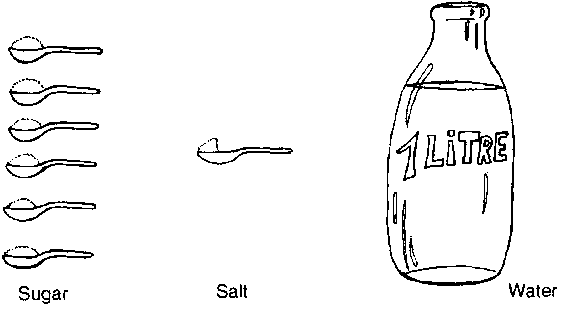
Constipation
Constipated animals cannot defecate or they pass very hard droppings with difficulty. The animal with constipation is easy to spot.
Constipation is treated by giving an enema. Warm soapy water is injected into the rectum. Epsom salts or commercially produced oils (see R22 Annex 1) can be given by mouth to relieve constipation.
Constipation
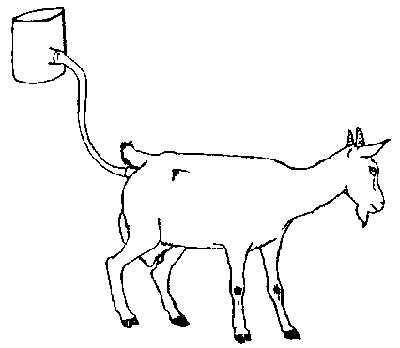
|
Saliva is produced by glands in the mouth and helps in the chewing and swallowing of food. Excessive salivation, when saliva shows as dripping, threads or froth around the mouth, is not normal. Excessive salivation accompanied by mouth lesions and fever is a sign of disease. |
Learning objectives
After studying this unit you should know:
1 Recognise excessive salivation.
2 Recognise choking (feed stuck in the gullet).
3 Know the types of mouth lesions.
4 Blisters in the mouth.
5 Treatment of mouth problems.
Excessive salivation
Excessive salivation accompanied by chewing movements may be caused by a number of different things. Open the animal's mouth and check what is causing the problem. It may be due to:
· Foreign bodies (thorns, nails, pieces of feed) in the mouth or between the teeth
· Teeth problems and abscesses
· Poisoning
· Pieces of feed stuck in the oesophagus (gullet) causing choking
Choke (feed in the gullet)
This happens when large or dry pieces of feed become stuck in the gullet (oesophagus). It is common in cattle and can occur in horses. The obstruction must be removed.
Choke in ruminants causes bloat (tympany). The best way to remove the obstruction is to push upward toward the mouth from the outside on the left side of the neck.
Another way is to press hard on the top of the mouth with your fingers to make the animal open its mouth. Then pour a small amount (10 - 20 ml) of oil into the mouth of the animal or pass a stomach tube down the gullet (see Annex 3).
Salivation accompanied by mouth lesions
Sometimes an animal produces excessive saliva which drips or froths from the mouth. This is because of a lesion in the mouth or on the tongue or lips. Mouth lesions can be:
· Red spots and blisters (watery fluid filled bags of skin) in the mouth
· The skin comes off from some areas leaving red tissue showing
· The tongue is swollen
Excessive salivation, mouth lesions and fever are signs of infectious disease and you should get your veterinary officer to look at the animal immediately.
Rinderpest and foot and mouth disease (see Unit 25) cause excess salivation and mouth lesions. Other diseases also cause these signs.
Dress lesions of the mouth with antiseptic (see R 3 Annex 1). Your veterinarian may recommend antibiotic injections for several days
|
It is important to know the body temperature when checking the health of an animal. Use your thermometer to take the body temperature if you think an animal is sick If the body temperature is higher than normal (see Unit 4) the animal has a fever. Fever is one of the commonest signs of an infectious disease. A small rise in body temperature is called a slight fever and a large rise is called a high fever. When the body temperature is lower than normal the animal has a subnormal temperature which could be caused by starvation, bleeding or dehydration. Fever, like diarrhoea, causes the animal to lose a lot of water and salts from the body. |
Learning objectives
After studying this unit you should know:
1 When an animal has fever.
2 What causes fever.
3 What to do with a fevered animal.
Fever
You should know the appearance of the healthy animal (see unit 5). If you believe that an animal is not healthy, talk to the owner or keeper to discover all that you can about it. Examine the animal and use your thermometer to take the body temperature.
If the body temperature is higher than normal the animal has a fever. The increase in the temperature tells you how great a fever the animal has.
The normal body temperature of sheep is 39°C. If the temperature is 40°C or 41 °C then the sheep has a slight fever. If the temperature is from 41.5°C to 42°C then the animal has a high fever. A temperature of 38°C is subnormal.
For all animals a rise of 1°C or 2 °C in body temperature is a slight fever while any temperature more than 2°C above normal is a high fever.
The cause of fever
Fever, especially high fever, is the result of an infectious disease caused by germs (see Unit 6). When some types of germs get inside the body of an healthy animal, it will become sick. Animals can get germs from:
· Breathing in germs from the air.
· Dirty water and bad feed.
· Dirty animal housing from which droppings and urine have not been cleaned.
· Milk, saliva, urine or blood from sick animals.
· Fly bites and injuries.
Treatment of fever
If an animal has a fever, separate it from the others and keep it in a shady, cool place with plenty of clean, fresh water. If the animal has a slight fever and shows no diarrhoea, constipation, discharge from the eye or mouth or any other signs of ill health, it should be given some good feed. Keep a check on it for a day or two to see if the fever drops.
If the animal has a high fever and diarrhoea, a discharge or other signs of ill health you should give it only clean fresh water and if possible get veterinary help. If you cannot get veterinary help for an animal with a high fever you can give it an antibiotic or sulpha drug by injection or by the mouth for at least three days to kill the germs (see R6, R7, R9, R10 Annex 1).
Watch closely for signs of improvement over the next two days. If the animal does not return to normal (eating, drinking and movement) you will have to contact the veterinarian to discover the problem and to how to treat it.
|
A cough is a strong, forceful expiration (breathing out) through the mouth. A sneeze is a short, forceful expiration through the nose. Difficulties in breathing and very fast breathing are other problems of the respiratory system and are not normal conditions. Breathing problems accompanied by fever and discharge from the nose are very bad signs and mean that the animal has an infection. |
Learning objectives
After studying this unit you should know:
1 When an animal has a cough.
2 Sneezing.
3 Discharge from the nose.
4 Treating animals with respiratory problems.
Coughing
A cough is a strong forceful expiration (see Unit 3). Coughing is caused by:
· Infectious diseases of the lung or windpipe.
· Parasites in the lung.
· Fluid or mucous in the lung or windpipe.
· A medicine (drench) going into the lungs instead of through the gullet to the stomach.
Pigs can cough as a result of being given dusty (powdery) feed.
Sneezing
A sneeze is a strong, forceful expiration through the nose. It can be caused by an infection of the inside of the nose or from maggots of the nasal fly (see Unit 64).
Difficulties in breathing
Infection of the lungs or windpipe will cause the animal to have difficulty in breathing. It will make noises as it breathes.
A blockage of the windpipe caused by a foreign body or an abscess will also cause difficulties in breathing.
Fast (rapid) breathing
Fast breathing is caused by an infectious disease and is associated with a fever. It is easily noticed by looking at the movements of the chest as the animal breathes.
Treatment
If an animal coughs, and there is no discharge from the nose or a sign of fever, you should suspect a foreign body, dust in the windpipe or lungs or lungworms as causes of the problem. Check for any foreign body or if necessary treat for lungworms (see R11, R12 Annex 1).
A cough accompanied by a fever and discharge from the nose and eyes is caused by an infection. You should ask your veterinarian for help but if this is not possible you can give the animal antibiotics or a sulpha drug (see R6, R7, R9, R10 Annex 1) for three or more days.
Sneezing when there is no fever is caused by a foreign body or nasal fly maggot in the nose. If an animal has a foreign body or abscess in the windpipe it will have difficulties in breathing but will not have a fever.
|
Injury or infection of the eye or vitamin deficiencies can cause blindness in animals. Blind animals may not survive because they will be unable to find feed. A problem in one eye is the result of injury or a foreign body. A problem in both eyes accompanied by fever, means that the animal has an infection or a serious disease. If blind in both eyes but without a fever, you should suspect a vitamin deficiency such as deficiency of vitamin A or B to be the cause. |
Learning objectives
After studying this unit you should know:
1 The structure of the animal eye.
2 Causes of eye problems.
3 Treatment of eye problems.
The eye
The eye is important to the survival of the animal. The glass-like surface of the eye is called the cornea. The eye can be covered by the eyelids which protect it.
The eye
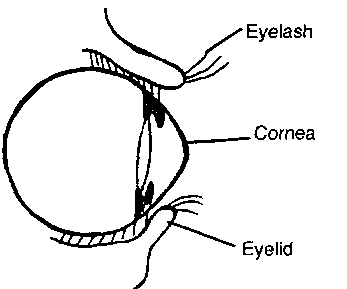
Eye problems
If one eye is red, swollen and watery this may be due to:
· A foreign body such as sand, dust or a seed in the eye.
· An injury or cut to the cornea.
· Eye infection caused by flies or dirt.
If both eyes are swollen, red and watery and perhaps the animal is unable to open its eyes, this is a sign of infection. You should check the body temperature for fever. Many diseases cause eye problems.
Blind animals
It can be easy to spot a blind animal as it will start to walk into objects. A blind animal will be difficult to keep.
To check for blindness make a threatening (quick) movement towards the animal's face with your hand without touching the animal or creating a wind which it might feel. If it does not blink, it is usually blind.
Vitamin A, which is present in green feed, silage and good hay is important for good eye sight. If animals are fed only old, dry feed or graze pasture in drought areas they develop night blindness and cannot see at dusk or night.
Treatment
To treat eye problems you should:
· Ask someone to control the animal for you if it has a foreign body (dirt, sand) in the eye.· With clean hands, and using the thumb and first finger, open the eyelids and press gently inwards.
· Use a clean, soft cloth to remove the foreign body from the eye.
· Put a drop of oil or ointment in the eye.
Treatment
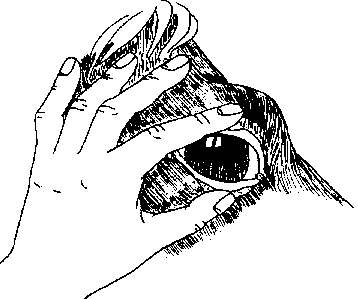
If you have difficulty in removing a foreign object:
· Put a drop of olive, castor or cod liver oil in the eye as this can help to remove dirt.
· Put a little sugar in the eye, this will cause tears which will wash out the eye.
Use eye drops or ointment to treat red, swollen eyes (see R23 Annex 1).
Treatment

If you cannot open a swollen eye do not force the eyelids open. You must get veterinary help. If both the eyes are swollen, red and watery and the animal has a fever put the animal in a shady place away from others. This is a sign of infectious disease and the animal may need to be treated with antibiotics.
Vitamin A and B1 deficiency are prevented by feeding silage or supplemental feed during the dry season. These vitamins can also be injected (see R28 Annex 1) to treat these vitamin deficiencies.
|
A wound is a cut or tear in the skin. All wounds bleed, they are painful and can become infected with germs or maggots. Sometimes an animal can bleed from wounds inside its body which have been caused by parasites, by an accident, or in the female from problems as she gave birth. This is infernal (inside) bleeding. The blood carries oxygen from the lungs to every part of the body. If the body loses too much blood it will not get enough oxygen and the animal will die. All wounds should be carefully cleaned and the bleeding stopped. |
Learning objectives
After studying this unit you should know:
1 The causes of wounds.
2 First aid for wounds.
3 How to stop bleeding.
4 Internal bleeding.
5 Treatment of old wounds.
6 The navel cord and wounds from castration.
First aid for wounds
Animals can be injured by the horns and bites of other animals, thorns and sharp objects such as glass, wire and nails. These wounds will become infected with germs because of the conditions in which animals live.
If there is not too much bleeding, clean the wound with salt water and remove all dirt from it. Cut away the hair or wool from around the wound. If you have any disinfectant (R1 Annex 1) use it to dress the wound. Dusting powder can be used to keep the wound clean (R5, R8 Annex 1).
Bleeding
Bleeding from small or surface wounds can be stopped by pressing down hard on the wound with a clean cloth. If the blood soaks through the cloth put another on top rather than remove the first one. When the bleeding has stopped clean the wound and treat it.
You will need veterinary help to deal with bleeding from large or deep wounds. If you cannot stop the bleeding by pressing down with cloths you can use a tourniquet.
A tourniquet is a piece of rope or cloth which is tied across a blood vessel. It can only be used for wounds in the legs or tail.
You do not use a tourniquet around the neck.
Bleeding
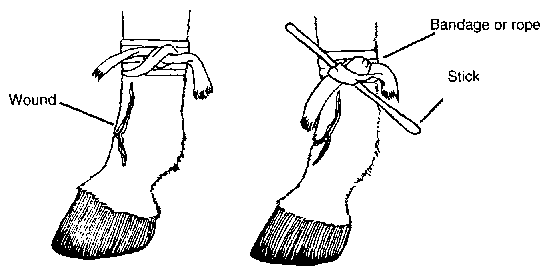
Tie the rope around the limb above the wound. To tighten it put a stick under the rope and twist it tight until the bleeding stops. Do not leave the tourniquet on for more than 20 minutes. Release it slowly and if necessary tighten it again. Clean and treat the wound after the bleeding has stopped.
Bleeding from a broken horn
If the horn of an animal is broken, try to stop the bleeding by putting a pad or clean cloth on it and holding it in place with a bandage. A temporary tourniquet around the base of the horn will stop bleeding.
If this does not stop the bleeding, a red-hot piece of metal can be placed directly on the bleeding spot for half a minute to cauterize the horn and the blood vessel. This may have to be done to several bleeding spots on the horn or to the skin surrounding the horn.
Bleeding from a broken horn

Remember do not leave a tourniquet on for a long time. If bleeding continues release the tourniquet every 20 minutes and then tighten it again.
Internal bleeding
This type of bleeding is dangerous. It can be:
· From the lungs and gut after an accident
· From the uterus or vagina after giving birth
The signs of internal bleeding are that the animal becomes weak and the rate of breathing increases. An animal with internal bleeding should be placed in a quiet, warm place and should be given water with a pinch of salt in it. Do not try to walk the animal as it may collapse and die.
You will need to ask for veterinary help if you believe that an animal has internal bleeding. In many cases there is nothing you can do to stop it. It is better to slaughter the animal.
In the horse and donkey internal bleeding from the vagina can occur after birth. If you cannot get veterinary help, pack the vagina with a clean cloth or towel which has been boiled and then cooled. Leave the towel in the vagina for a day or two then remove it.
Old wounds
If wounds are left without treatment maggots will infest the wound and cause more damage.
In some cases gangrene will develop in a wound. The wound worsens and turns black in colour with a very bad smell. Ask your veterinarian for help immediately.
Wounds from operations
Wounds can be caused by operations carried out on the animal. Wounds are caused by:
· Castration
· Docking (cutting the tail)
· Dehorning (removing the horn)
· Cutting the navel cord immediately after birth
· Cuts when the wool was sheared
All wounds should be cleaned with disinfectant (see R1 Annex 1). If you have a powder for wounds (R5, R8 Annex 1) you should use this daily until they heal.
Infected wounds or operations often swell from pus. The swelling is soft to the touch. These wounds, called abscesses, should have the pus removed by cutting through the skin with a sharp knife or scalpel to allow the pus to drain out. Abscesses are treated daily to keep the drain incision open, squeeze out the pus and flush out the wound with clean water or liquid disinfectant (see R1 Annex 1). An antibiotic or sulfa drug should be given by injection or orally for 3 -5 days (see R6, R7, R9, R10 Annex 1).
|
If a bone is broken and there is no wound or bleeding it is called a closed fracture. When the bone is broken and there is bleeding this is called an open fracture. Bone fractures in animals are difficult to treat especially in large animals. It may be possible to successfully treat leg fractures in small, young animals. You will need veterinary help to deal with all sorts of broken bones. |
Learning objectives
After studying this unit you should know:
1 What can cause fractures.
2 Signs of fractured bones.
3 Treatment for fractures.
4 Dislocation of bones.
Cause of fractures
A fracture is a broken bone. Any one of the bones in the body can be broken but it is most common for the bones of the legs to be broken.
Fractures can result from the animal being kicked, falling, putting its leg in a hole or from fighting another animal.
How to recognise when a bone is broken
A fracture will happen suddenly, it is not like a disease which takes time to develop. Sudden pain and an abnormal movement (lameness) often mean a fracture.
The animal will be unwilling to use the part of its body where the fracture is. You may hear the sound (crack) of the two ends of the broken bone as the animal moves. The area around the closed fracture will become swollen.
In an open fracture there will be a wound and bleeding. The ends of the broken bone may show through the wound.
Dislocation of bones
This happens when the ends of two bones (joint) move apart from each other. You can feel that the joint is dislocated when you touch it.
Dislocation of bones

Treatment of fractures
In the case of a large animal you must prevent the animal moving and ask for help from your veterinarian. He may decide that the animal should be slaughtered.
Broken legs commonly occur in small or young animals. It may be possible to treat. You should ask your veterinarian for help but if this is not possible ask the community health worker or the bone setter in the community to splint it. You can sometimes put dislocated bones back into place if you have someone to help you.
|
A lump under the skin can appear in any place on the body. Lumps may grow and increase in size or stop growing. Some are hot and painful. Some lumps contain pus (yellowish matter) or blood. |
Learning objectives
After studying this unit you should know:
1 What are abscesses.
2 Abscesses of the lymph nodes.
3 How to treat abscesses.
4 Blood lumps under the skin.
5 What are hard lumps under the skin.
Abscesses (lumps of pus)
Abscess means infection under the skin. An abscess is a swollen, red and painful lump under the skin. It contains pus (yellowish matter).
An abscess is caused by germs. Germs get under the skin by:
· Bites from other animals or insects such as ticks and flies.
· Sharp objects such as thorns or nails piercing the skin.
· Injections or vaccinations which have been done with dirty needles.
· Diseases cause abscesses. The lymph nodes (glands) can develop abscesses in some diseases (see Unit 3).
Abscesses in the lymph nodes (glands)
The lymph nodes in animals are similar to those which you have in your body under the jaw and armpits. When an animal is infected the lymph nodes (glands) often become swollen and can be felt as lumps under the skin. In some diseases this swelling becomes an abscess.
Abscesses in the lymph nodes (glands)
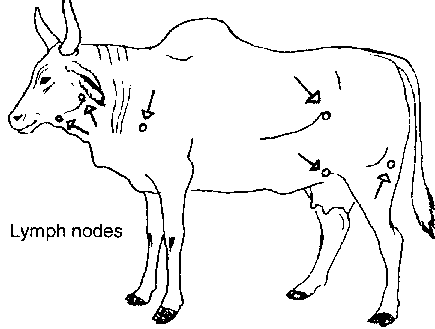
Treatment of abscesses
Some abscesses will break open and the pus will come out. You may need to open an abscess and can do so when it is soft. To do this quickly you should:
· Clean the abscess and the area around it with soap and water. Stick a clean needle into the abscess. If blood comes out put the needle into another point on the abscess. If pus comes out when the needle is put into the abscess, remove the needle and with a clean sharp knife, razor blade or scalpel make a small hole through the skin into the pus pocket. Then cut downwards through the skin into the pus and allow the pus to drain out of the abscess.· When the pus has been removed, the abscess is treated as a wound (see Unit 73).
· If the abscess is not ready to open soak a cloth in hot water and put it over the abscess for 10 minutes at a time. You will need to do this 4 times daily for a few days until the lump has become large and soft and can be opened.
Pus contains germs. You should clean up the pus and collect it in a piece of paper or cloth and burn it. Wash the area of skin around the abscess. Wash your hands and disinfect all needles and instruments used.
If the abscess is deep under the skin and does not break and the animal has a fever, you will need to ask your veterinarian for help. Antibiotics or sulpha drugs can be given by mouth or by injection for 3 days (see R6, R7, R9, R10 Annex 1) if you cannot get veterinary help.
Do not open abscesses of the lymph nodes but give an antibiotic or sulfa drug for 3 days to treat the infection.
Lumps of blood under the skin
This will result if an animal has been kicked or beaten. The lump is soft and not hot or painful and will disappear in 2 to 3 weeks.
You should not hit animals or try to lift an animal by holding its skin. This will cause blood lumps under the skin. If you want to sell animals for slaughter this will show as red-blue areas in the meat.
Solid lumps
These are hard lumps which are not hot like abscesses or soft like blood lumps. Solid lumps may increase in size continuously or stop growing after some time. You will need to ask your veterinarian for advice on an animal which develops this type of lump.
Strangles in horses
This is an abscess of the lymph glands under the jaw in young horses, mules and donkeys. The animal has a high temperature, there is an abscess under the jaw and a thick creamy discharge from the nostrils. You must isolate the animal and get veterinary help to open this abscess. When the abscess has been opened, the animal can be treated with antibiotics.
Strangles in horses
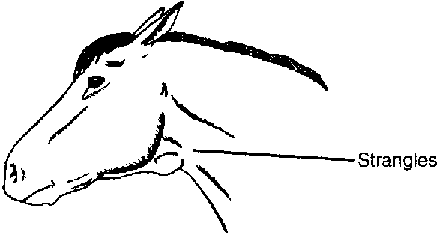
|
Animals do not normally eat poisonous plants. A lack of other feed may cause animals to eat such plants. They may eat unfamiliar poisonous plants if they are moved to a new area where there are different poisonous plants. Poisons such as warfarin (rat poison) and strychnine can be the causes of poisoning of animals. Arsenic dips may still be used in some areas and can lead to poisoning. Sometimes animals are purposely poisoned by people. Snake bite is the most common form of dangerous poisoning. |
Learning objectives
After studying this unit you should know:
1 Signs of poisoning in animals.
2 Causes of poisoning of animals.
3 Treatment of poisoned animals.
4 How to treat snake bites.
Signs of poisoning in animals
A poisoned animal may die suddenly or will show the following signs:
· Excessive salivation.
· The mouth is open and the tongue hangs out.
· Diarrhoea and vomiting.
· Difficulty in breathing.
Causes of poisoning in animals
There are many causes of poisoning in animals:
· There are very many poisonous plants. You should talk to your community and discover what poisonous plants are in your area.· Seeds for planting may have been treated with chemicals. If animals or humans eat these they can die..
· Strychnine is a poison which can be used to kill wild dogs and wolves. It will also poison other animals
· Weed killers used in agriculture may be poisonous.
· Chemicals used to kill insects on plants or used for dipping against external parasites.
· Old paints, kerosene, diesel and other fuels and oils.
· Poison used to kill rats and mice.
· Animals can be poisoned by salt if they are not able to drink a lot of water.
Sometimes people deliberately poison animals.
Treating poisoned animals
You can not do much in a case of poisoning. You should ask for veterinary help as soon as possible. Try to discover what caused the poisoning and stop other animals from being poisoned.
· Charcoal mixed with water and given as a drench is a good treatment for poisoning. Give 1 g m for every 20 kg of body weight.· Kaolin (china clay), a white powder, can be mixed with water and given as a drench. Give 10 gm to a small animal and 200 gm to a horse or camel.
Snake bites
There are numerous snakes which are poisonous to animals and man. Animals are mainly bitten in the face and legs.
Usually we discover the animal was bitten by a snake when it is too late to do anything. If you are with an animal when it is bitten, you should examine the animal and move the hair or wool to find the two small, but deep, wounds made by the fangs of the snake.
You should use a tourniquet (see Unit 73) to stop the poison from a bite on the leg going through the body. Release the tourniquet every 20 minutes to allow the blood to flow. You should send for veterinary help immediately as it will be necessary to give the animal an injection against the snake poison.